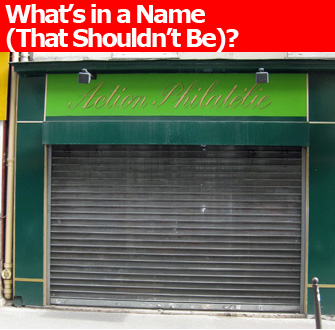
There are approximately 220,000 businesses in Paris, so it’s not surprising that some of them have startlingly idiotic names. Ridiculous shop signs come in many varieties. One common category is the illogical juxtaposition, an example of which is shown above. Here’s another:
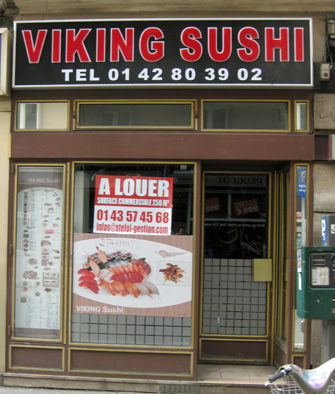
From Leif Eriksson’s log, July 15, 1012:
Day 23. Vinland hove into view at last, and we all gave out a lusty huzzah. It has been a long voyage sorely plagued by rough seas and rower’s elbow, although the raw cod has been plentiful and delicious. Tragically, a storm three days out of Reykjavik left the nori soaking wet and the coffer of wasabi was washed overboard by a swell. The men have been in foul humor ever since, but they shall have a double ration of mirin tonight.
Here we have a representative of another category that I call the “nice try”:

Let’s see here. It’s a hotel, all right. And it’s on Rue Clignancourt. Check. But “grand”? I have to give it two out of three.
For the Anglophone resident of Paris, the richest source of ludicrous signage is, of course, misguided uses of English. These have become easier to find in recent years as French society becomes more cosmopolitan and English becomes trendier (blame Hollywood). This results in ill-advised choices like:
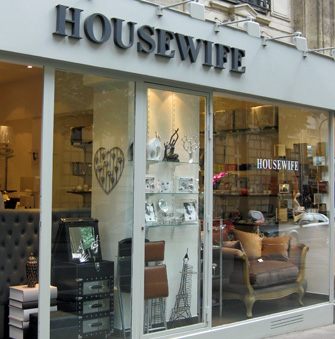
I suspect that the owners of this top-end homeware store in an upscale neighborhood thought they could appeal to their high-class clientele with a word lifted from the title of a popular U.S. sitcom that was imported to France. They might have done better calling the place “Desperate.”
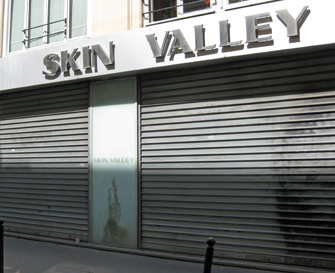
A cosmetics shop? A porn den? No, it’s a leather-goods outlet. At a guess I would say that the name is meant to evoke “Sun Valley,” which would be a nice positive image. But for the native English speaker it more readily evokes “Where-the-Sun-Don’t-Shine Valley,” which is, well, not so nice.

Judging from the posters plastered all over the interior, the owner is obsessed with Al Pacino in general and the 1983 remake of Scarface in particular. But I rather doubt that even hardcore cinephiles make the connection at first glance between “food” and “face.” Or think it’s an appetizing combination when, at eighth or ninth glance, they finally do. I’ll have the Heidel-burger with a suture salad, please.
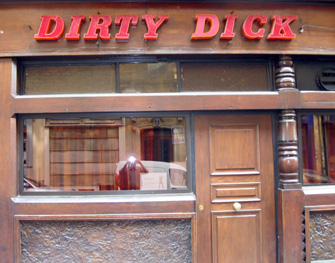
To a French person this name conjures up images of the Old West, six-shooters and sheriffs and outlaws and all that, making this an appropriate name for a Western-themed “saloon.” But what makes it an especially inappropriate name for this particular saloon is that this is a hostess bar in the red-light district around Pigalle. At night, scantily clad cowgirls sit in the window flashing their assets to potential customers, hoping to lure them in so they can do a dance on their laps and a colonic on their wallets, which is why I went to get this photo in the morning. Still, I didn’t want to linger too long wielding a camera on a street where inquisitive strangers are not likely to be greeted with open arms (let alone any other appendages), so I ended up with a pretty bad shot — that’s me flashing in the window. Come to think of it, there’s a kind of symmetry there.
As a sub-category of lamentable English we have those commercial names that sound fine in the original language but just happen to mean something else to English speakers:
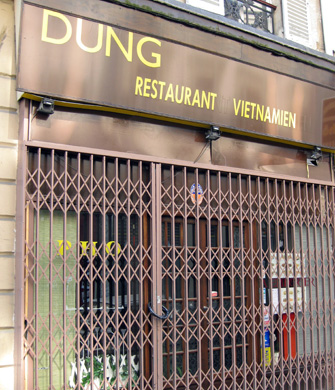
I’m sure it’s a really nice word in Vietnamese. It probably means “phlegm.”
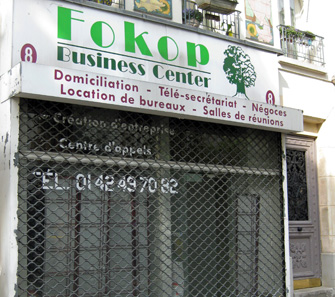
Ahh, guys? Maybe it’s not just the recession that’s keeping the clients away. The fact that “Business Center” is in English would tend to indicate that they should have known better.
Now we come my favorite category: signs that incorporate the name of a historical figure (usually because it’s the name of the street), thus creating an anachronism. In the Marais we have:
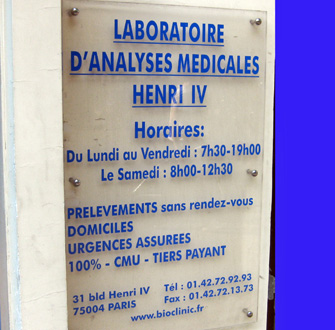
This is the medical laboratory where King Henri IV of France came to get a full checkup after his triumphant return to Paris in 1594. When his wife Marie de’ Medici gave birth to a son, the future Louis XIII, in 1601, Henri asked the lab for a DNA comparison. Shortly after delivering the results, confirming the king’s paternity, the head pathologist moved to Saint Tropez, where he bought an opulent seafront villa and opened his own business called the Laboratoire d’Analyses Médicales Marie de’ Medici.
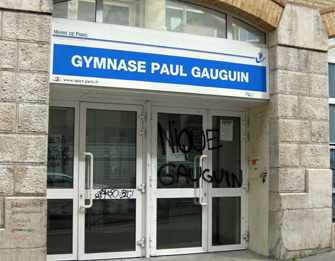
In 1889, the famous post-Impressionist started working out here three times a week in preparation for his upcoming trip to the Pacific after Vincent Van Gogh told him that Tahitian women can’t say non to a guy with buff abs. This turned out to be Van Gogh’s idea of a practical joke, and led to their falling out. When the Dutch artist came by the gym to reveal that it was all a put-on, Gauguin became so angry he punched his former friend in the chest, knocking him onto a NordicTrack machine. Van Gogh’s left ear got caught in the treadmill.
Avenue Mozart in western Paris is rife with this type of sign. There’s a Mozart drugstore, a Mozart rug store, a Mozart Chinese takeout joint, and a laundry:
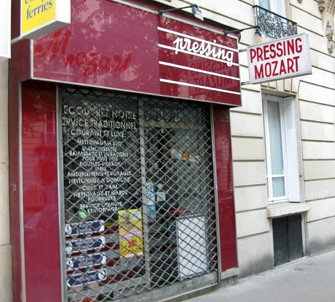
Presumably where the Austrian prodigy had his stage outfits dry cleaned when he was in town.
But the best of all is:
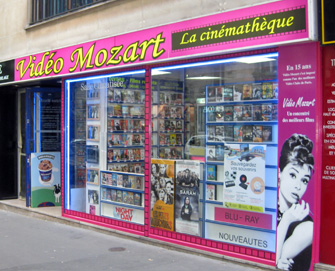
This is the legendary studio where Wolf and the Gang produced all of their video clips when they were on tour in Paris, including “Toot My Magic Flute Baby,” “Cosi Fan Booti” and “The Shackup of Figaro.”
Note: Seen a ridiculous sign in Paris? Send a photo to contact@parisupdate.com
© 2011 Paris Update
FavoriteAn album of David Jaggard’s comic compositions is now available for streaming on Spotify and Apple Music, for purchase (whole or track by track) on iTunes and Amazon, and on every other music downloading service in the known universe, under the title “Totally Unrelated.”
Note to readers: David Jaggard’s e-book Quorum of One: Satire 1998-2011 is available from Amazon as well as iTunes, iBookstore, Nook, Reader Store, Kobo, Copia and many other distributors.
